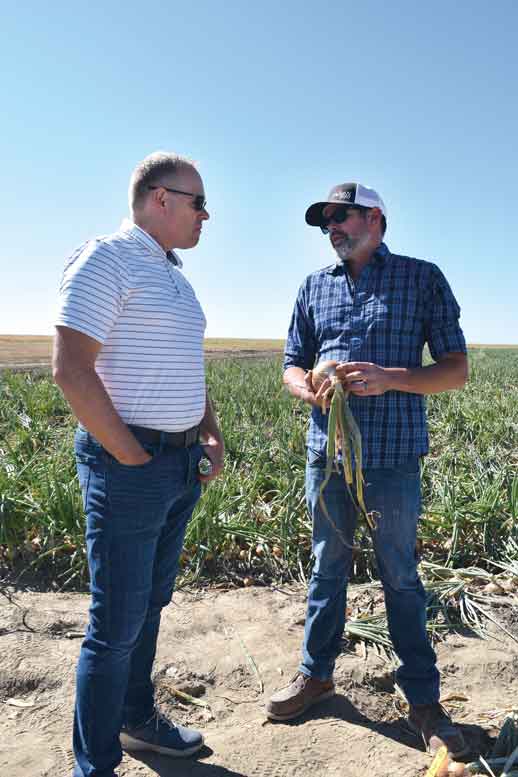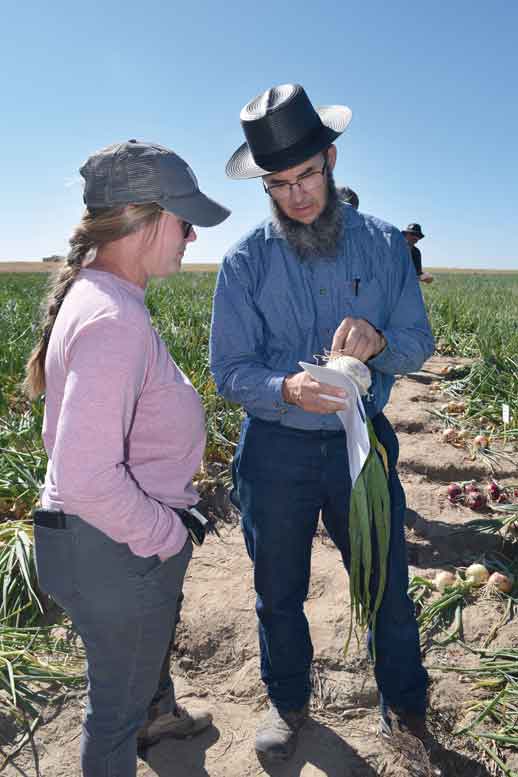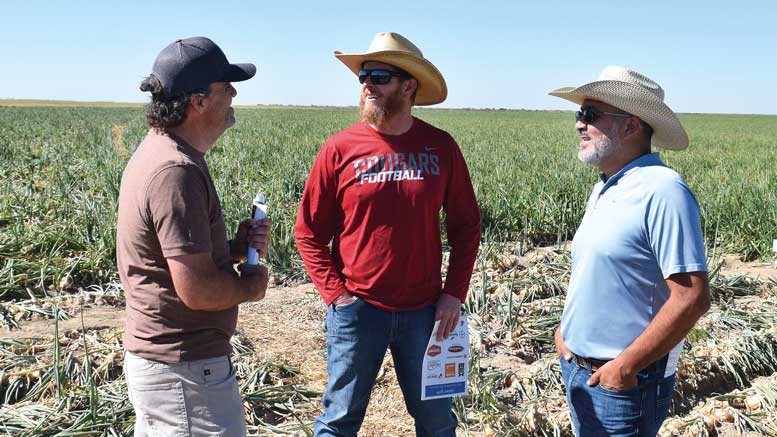|
Click to listen to this article
|
Story and photos by Denise Keller, Editor
It was a fairly easy year to control thrips in the Columbia Basin, according to an informal show-of-hands survey by Washington State University’s Tim Waters at the WSU Onion Field Day, held Aug. 29 at Hartley Farms near Prosser, Washington. Waters said that the region’s relatively cool weather early on slowed thrips development, and for growers on top of their game making timely insecticide applications, it was a pretty easy year to manage the pest. However, knowing that another year of thrips control is always around the corner, Waters shared with field day attendees helpful tips to control thrips, as well as strategies to manage seed corn maggot in onions.

Thrips Control
Currently, there are a lot of tools available to manage thrips, with another product on the way. Between Minecto Pro, Exeril, Movento, Agri-Mek, Radiant and Lannate, growers should be able to do a fairly good job managing thrips, Waters said; however, he reminded his audience of the importance of scouting their fields early.
“It’s really important to remember with thrips, you don’t want to get out to a late start. If you go out and you have 15-20 thrips per plant, you probably missed the boat by about 10 days,” Waters said. “Generally, in our region, at about the three- to four-leaf stage is the time you want to start applying insecticides for thrips control – when you get about one to two thrips per plant.”

Starting early and keeping populations low while plants are small is important to protect the early leaves that drive photosynthesis. Protecting the crop early will also significantly reduce the impact of Iris yellow spot virus (IYSV), including potential yield reduction. When thrips populations are building rapidly, multiple applications should be separated by about a week and intervals can be shortened to get better control.
Addressing insecticide resistance management, Waters reminded growers to not overuse the available chemistries. He recommended making no more than two applications of any active ingredient per year, being sure that the two applications are back to back to avoid exposing multiple generations to the product. In recent years, thrips populations have been developing some resistance to Lannate. Therefore, Waters recommended using Lannate more sparingly than in the past, and if growers notice a lack of control, refrain from making more than one application.
A new active ingredient is expected to be registered in the second half of 2025. Plinazolin is a new mode of action for thrips control that has been effective in WSU trials. The insecticide can be used for foliar applications, offers a broad spectrum of control and will be a good tool to add to the mix, Waters said.

Maggot Management
Moving on to discuss seed corn maggot management, Waters reported that it was a pretty light year for seed corn maggot in the Pasco, Washington, area, while some fields around Moses Lake, Washington, got hit harder.
When conditions are cool in the spring and onions take longer to emerge, plants are more highly susceptible to damage by seed corn maggot. When this happens, stand is compromised and, in turn, yield is reduced from that plant and the plants around it because the surrounding onions tend to become large and blow out their basal plate.
Management options are limited, especially given the loss of former standby products Lorsban and chlorpyrifos. The availability of diazinon is expected to diminish fairly soon, Waters reported, and neonicotinoids, which are included in package mixes, are also at risk.

“The one thing that scares me quite a little bit is neonicotinoids are constantly under scrutiny right now, and we’re worried we’re going to lose those,” Waters said. “When we lose neonicotinoids, we’re going to have a different discussion about seed corn maggot management.”
Seed treatments should help sufficiently manage moderate populations. Sepresto works relatively well under moderate pressure, according to Waters, and FarMore packages are still quite effective. If dealing with higher populations, a quick water lap with a pyrethroid will help knock back some of the adults. While the treatment is only moderately effective, it is sometimes the best option available.
Researchers are looking at alternative chemistries and seed treatments. Plinazolin, which offers very good efficacy and also benefits from having a package mix, will not be labeled in the first year as a seed treatment, but possibly down the road, Waters said.

